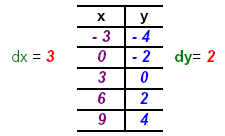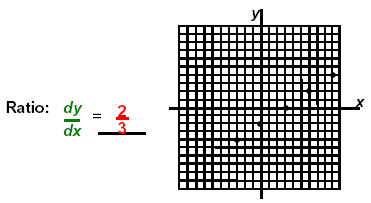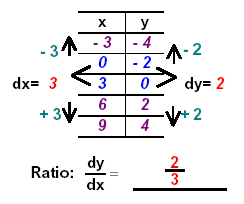|
Home |
Graphing Linear Equations in Two-VariablesBuild a table of ordered pairs where the x-values are in a sequence and the y-values are in a sequence. When you plot these points (ordered pairs) you will see that they form a straight line. Always choose only an integer as the replacement for the x-value so that the resulting y-value will be an integer, and visa versa. If we put a “sequence of integers" in the table for x , complete the computation for each x-value, and put each corresponding y-value in the table, then the y-values in the table will be a “sequence of integers". Write the common differences. 1. Given 2x − 3y = 6 build the table for using an arithmetic sequence as replacement values. Note: In this equation if you choose consecutive integers for x you will find some y-values that are fractions. By noting that the constant 6 is a multiple of 3 and the coefficient of y is 3, you can choose your sequence for the x-values to be multiples of 3 . Now, when you are solving for the y-values and divide by the coefficient-3 you will obtain a sequence of integers for the y-values.
Check to see that both columns of values are arithmetic sequences.
The following is another approach to graphing this equation.
If both the x-intercept and the y-intercept are integers, we can place them in the middle of the table. Then we can find the difference in the x-values for dx and the difference in the y-values for dy and use these differences to build arithmetic sequences for the table.
Now you must CHECK the top and bottom points in the table to be sure that they are points on the line: For the point (- 3, - 4) replace x = - 3 and y = - 4 in the given equation 2x − 3y = 6 CHECK:
For the point (9, 4) replace x = 9 and y = 4 in the given equation 2x − 3y = 6 CHECK:
|
||||||






